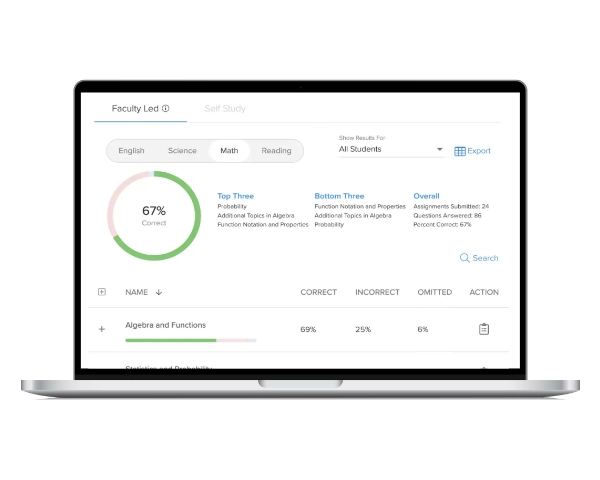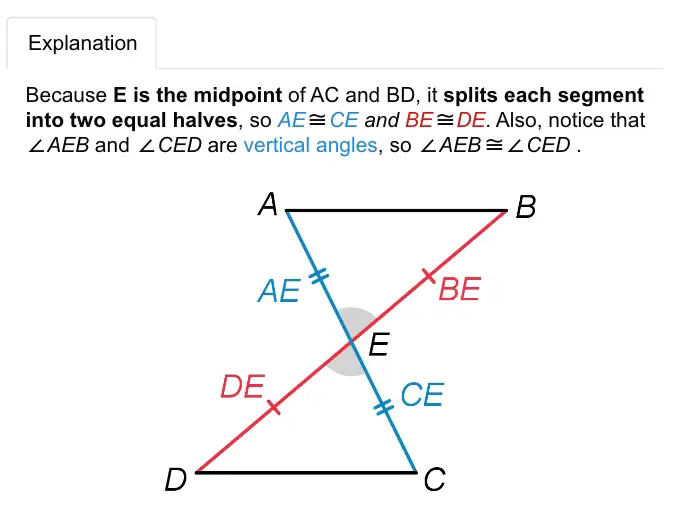Preparing your students for the ACT and SAT can feel like a balancing act. By aligning test prep with your school or district’s unique schedule, you can ensure consistent, meaningful practice that fits seamlessly into your academic year. Let’s explore 3 implementation pathways you can adopt to guide your students toward ACT and SAT success.
Pathway 1: Integrate ACT and SAT Prep Into Core Classes
Help your students master the ACT and SAT by embedding practice questions, aligned to their exact format and rigor, into your core curriculum. This dual-purpose approach reinforces key concepts in math, English, and science while familiarizing students with test styles, boosting confidence and readiness for exam day. You save time by seamlessly integrating college readiness-level prep into daily lessons, ensuring your students are prepared without additional stress or instructional adjustments.
Beginning of Year (BOY)
Start the year by incorporating PSAT, PACT, or UWorld pre-tests to establish a student performance baseline and identify improvement areas. Use the results to create individualized learning plans, helping each student set measurable goals based on their strengths and weaknesses. Schedule early 1-on-1 conferences to walk students through their results, set performance targets, and establish an understanding of the importance of ACT and SAT prep. You may even consider hosting a classroom kickoff session that highlights how test prep will be integrated into regular coursework throughout the year.
Actionable Tip: Use the pre-test results to group students based on skill level for small, targeted breakout sessions during class time. This can help you provide differentiated instruction, ensuring students receive the support they need right from the start.

First Semester
Dedicate 15-30 minutes weekly to ACT and SAT practice by embedding test-style questions into your core math or ELA lessons. Rotate low-difficulty questions aligned with current classroom content, gradually building familiarity with test formats. This consistent, low-pressure exposure reinforces fundamental skills while reducing student anxiety about standardized testing. You can also weave practice problems into warm-ups or exit tickets to keep test prep low-maintenance yet impactful.
Actionable Tip: Start each class with an ACT or SAT question of the day, using it as a quick bell-ringer activity. This keeps test prep consistent without disrupting your planned lesson flow.
Midterm
Administer a practice ACT or SAT exam as a mid-year checkpoint to evaluate progress and recalibrate instruction. Use performance data to identify student trends, adjust lesson plans, and provide additional support where needed. This checkpoint also allows you to tailor small group interventions to target specific skill gaps, ensuring your instruction remains focused and effective.
Actionable Tip: Use student performance data to create individualized remediation plans that focus on their most commonly missed question types. Break students into rotating stations that address different skill sets.
Second Semester
Transition to medium or high-difficulty practice questions, reinforcing more complex concepts during weekly class sessions. Introduce boot camps or focused review days that target higher-level problem-solving and critical-thinking skills. By consistently embedding test prep into the curriculum, you’ll keep students engaged and provide opportunities for skill refinement.
Actionable Tip: Create student teams and run small-group review competitions using medium-difficulty ACT and SAT practice questions. This builds camaraderie and helps reinforce learning in an interactive way.
End of Year (EOY)
Finish the academic year by reviewing practice test results and holding 1-on-1 conferences to reflect on student growth. Help your students develop next-step strategies for summer self-study or final test preparation. Celebrate progress to reinforce confidence and keep your students motivated as they approach official test dates.
Actionable Tip: Help students compile a "test-day tool kit" that includes their best strategies, common formulas, and key reminders they’ve collected throughout the year. This tool kit serves as a confidence booster and last-minute study guide.
Pathway 2: Implement Prep Into an Elective or College Readiness Course
Offering an elective or college readiness course dedicated to ACT and SAT prep gives your students a structured environment to develop critical test-taking skills over time. This pathway allows you to focus on instruction for targeted skill-building through practice tests, collaborative exercises, and deep dives into test-specific strategies. This approach enhances readiness for test day and integrates broader college preparation elements, helping your students navigate the admissions process more effectively.
Beginning of Year (BOY)
Start the year by administering a PSAT, PACT, or UWorld pre-test to assess each student’s baseline skills and identify specific areas of improvement. Meet with students individually to set realistic goals and outline strategies that can help them achieve their target scores. Consider introducing reflection exercises that allow students to evaluate their own performance and track their progress from the start. Hosting an orientation session to explain the importance of the course and how it fits into their broader academic journey can also help establish a sense of purpose and drive engagement.
Actionable Tip: Launch the course with a half-day boot camp focused on familiarizing students with the ACT and SAT structure, timing, and question types. By providing an early overview, you set the tone for ongoing practice and help students build confidence as they approach future lessons.
First Semester
Dedicate 1 class period each week to focused ACT or SAT practice, alternating between math and ELA to ensure comprehensive coverage. Begin with low-difficulty practice questions that reinforce foundational skills, gradually increasing complexity as students grow more comfortable with the format. Integrate peer activities such as group quizzes, collaborative problem-solving, and class competitions to keep engagement high. End each session with a brief recap, highlighting key takeaways and areas for improvement.
Actionable Tip: Incorporate leaderboard challenges that reward students for improvement and consistency rather than just top performance. This keeps all students motivated and focused on their personal growth.

Midterm
Midway through the course, conduct a full-length practice exam to assess progress and expose students to real testing conditions. After scoring the exam, meet with each student to review their results and adjust their personalized study plans accordingly. Use the data to identify class-wide trends and tailor the next phase of instruction to address common gaps. Consider dedicating a week to targeted review sessions that focus on the most challenging sections, providing additional practice and detailed explanations.
Actionable Tip: Facilitate a peer-driven review day where students explain their problem-solving approaches to one another. Encourage them to discuss correct and incorrect answers, promoting collaborative learning and reinforcing key strategies.
Second Semester
As the semester progresses, shift your focus to medium-to-high difficulty practice questions that mirror the more complex portions of the exams. Introduce boot camps or review intensives that focus on higher-order thinking and advanced problem-solving. Continue to dedicate regular class time to guided practice but encourage your students to take ownership of their learning by assigning independent review tasks. By gradually raising the difficulty level, you help students build the stamina and confidence they need to succeed.
Actionable Tip: Form small study teams and task them with presenting challenging test problems to the class. This reinforces their understanding while fostering leadership and collaboration.
End of Year (EOY)
Conclude the course by administering another full-length practice exam and conducting 1-on-1 debriefs to highlight growth and remaining areas of focus. Encourage your students to reflect on their progress and set goals for the final weeks of preparation leading up to the official test. Provide students with study guides and personalized review packets to reinforce critical concepts during independent study time. Closing the course with an emphasis on preparation and self-assessment helps instill confidence as they head into the actual exam.
Actionable Tip: Have students compile a “personalized test guide” that includes strategies, formulas, and tips they found most helpful throughout the course. This serves as a valuable last-minute review resource that boosts their confidence and preparedness.
Pathway 3: Deliver ACT and SAT Prep During Tutoring, Homeroom, or Guided Self-Study
Tutoring, advisory and homeroom periods, and guided self-study pathways provide a personalized approach to ACT and SAT prep, allowing your students to focus on the areas where they need the most improvement. This flexible model adapts to each student’s schedule and learning pace, making it ideal for those who benefit from 1-on-1 instruction or independent study. Tutors can tailor sessions to address specific weaknesses, while self-study programs, supported by platforms such as UWorld, provide comprehensive practice materials and performance tracking.
Beginning of Year (BOY)
Begin the year by assigning a PSAT, PACT, or UWorld pre-test to assess each student’s current performance and highlight areas for growth. Use the results to craft personalized study plans that break down content into manageable segments, ensuring that students can focus on weaker areas from the start. Collaborate with your students to develop weekly study schedules that align with academic demands and personal commitments, reinforcing the importance of self-discipline. Establish regular progress check-ins to help keep students accountable and motivated.
Actionable Tip: Encourage students to create a “study contract” outlining their weekly practice goals and benchmarks. This self-commitment builds accountability and creates a clear framework for consistent growth.
First Semester
Dedicate weekly tutoring sessions to low-difficulty ACT or SAT practice questions, focusing on building foundational skills in math and ELA. Emphasize the importance of mastering basic concepts before progressing to more challenging material, using real exam questions to build familiarity and confidence. Encourage your students to complete practice sections independently and bring problem areas to tutoring sessions for review. Use this time to reinforce test-taking strategies, such as process-of-elimination techniques and time management.
Actionable Tip: Create a reward system where students earn points for consistent practice or improvement. Small incentives, such as extra credit or study breaks, can help foster motivation and sustained effort.
Midterm
Administer a full-length practice test at the midterm point to replicate real exam conditions and assess student progress. Following the test, schedule 1-on-1 meetings to review results, analyze question patterns, and identify recurring mistakes. Dedicate a week to targeted interventions, offering supplemental resources and practice questions that directly address identified weaknesses. This recalibration ensures that the remainder of the semester focuses on meaningful growth.
Actionable Tip: Encourage your students to maintain an error log where they record incorrect answers and revisit them during weekly sessions. This reinforces learning and helps them track their improvement over time.

Second Semester
Focus on medium-to-high difficulty practice questions, gradually increasing the complexity of assignments as students gain confidence. Simulate real test environments by incorporating timed practice tests that reinforce pacing and endurance. Continue to prioritize high-impact review sessions that focus on advanced problem-solving and test-specific strategies. Encourage your students to tackle full-length sections independently, reviewing missed questions in detail during tutoring.
Actionable Tip: Host monthly timed mini-exams to mimic the pressure of the actual test. This regular exposure helps students improve their pacing and reduces anxiety ahead of the official exam.
End of Year (EOY)
As the academic year concludes, administer a final full-length practice test to evaluate overall progress and instill confidence. Review each student’s growth by comparing initial baseline data with current scores, reinforcing their achievements and identifying any lingering areas that require attention. Encourage students to refine their study strategies, focusing on small but impactful improvements in the final weeks leading up to the exam. Provide final review packets, including key tips, strategies, and practice questions for independent study.
Actionable Tip: Work with your students to compile a “final countdown checklist” containing last-minute reminders, exam day strategies, and motivational notes. This resource serves as a confidence booster and practical guide during the days leading up to the test.
How Teachers, Counselors, and Parents Can Support Test Prep
Creating a supportive and effective ACT and SAT prep environment requires a united effort from teachers, counselors, and parents. As a teacher, you can seamlessly weave test prep into daily lessons by incorporating practice questions, reviewing key skills, and offering test-taking strategies during core instruction. This steady exposure ensures that test preparation becomes part of the learning routine rather than an isolated task, reducing stress and reinforcing critical concepts over time.
Counselors can provide students with structured planning by helping them register for practice exams, access additional resources, and set realistic goals. Additionally, they can organize workshops or small group sessions focused on college readiness, ensuring students receive targeted support throughout the year.
Parents can foster a productive home environment by encouraging regular study sessions, limiting distractions, and supporting their child’s test prep journey. Providing positive reinforcement, celebrating progress, and promoting consistency at home can greatly enhance the skills being developed in school.
Tools and Resources for Effective ACT and SAT Prep
Equipping students with the right tools and resources will build a successful ACT and SAT prep program. By incorporating interactive platforms, adaptive practice tests, and structured instructional materials, you can create a well-rounded approach that meets diverse student needs. Online practice exams from UWorld mirror real test conditions, helping students build familiarity and reduce anxiety ahead of exam day. These simulations give students valuable experience in pacing and problem-solving under pressure, ensuring they are better prepared for the official test.
UWorld’s ACT and SAT prep tools go beyond standard practice by providing detailed explanations for each question, allowing students to understand why they missed certain answers and how to approach similar problems in the future. These resources offer data-driven insights, enabling you to monitor student progress, identify skill gaps, and tailor lessons to address areas of weakness. By embedding these tools into your classroom instruction, electives, or tutoring sessions, you create consistent learning opportunities that reinforce critical concepts throughout the year.
Creating a Roadmap to ACT and SAT Success
A well-structured approach to ACT and SAT prep empowers students to build skills gradually, ensuring they are confident and prepared by test day. By adopting flexible pathways — integrating test prep into core classes, electives, and tutoring — schools can meet students where they are academically while reinforcing key concepts throughout the year, fully preparing them for the ACT and/or SAT exams.
Explore the full potential of each pathway by downloading our ACT and SAT pathway guides for free.
References
- UWorld. (n.d.). 3 ACT pathways to success guide. UWorld. Retrieved from https://uworld.monday.com/protected_static/3487144/resources/1827603173/ACT%20Pathways_DIGITAL.pdf
- UWorld. (n.d.). 3 SAT pathways to success guide. UWorld. Retrieved from https://uworld.monday.com/protected_static/3487144/resources/1827603174/SAT%20Pathways_DIGITAL%20%282%29.pdf





